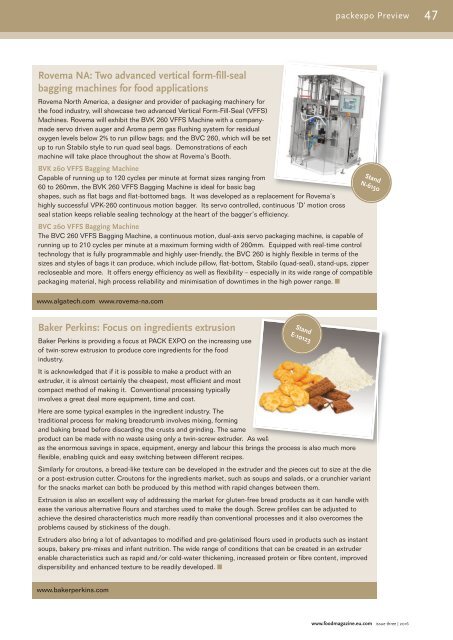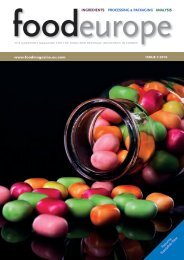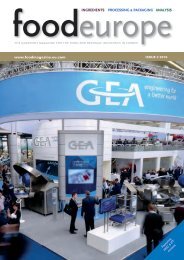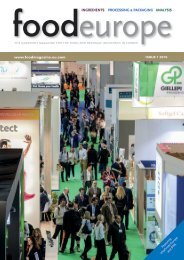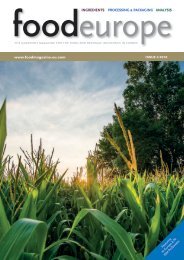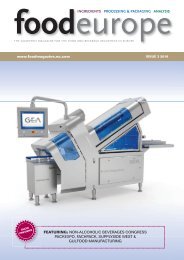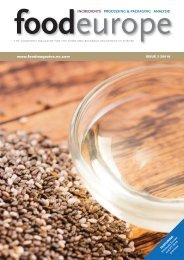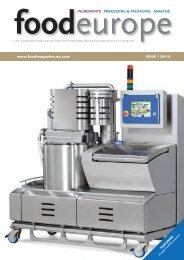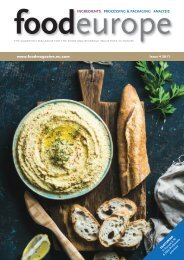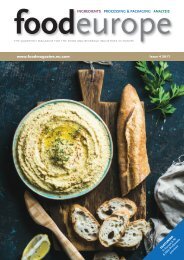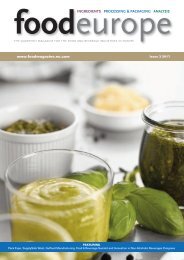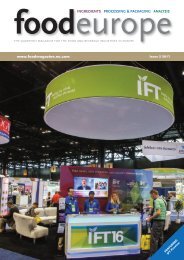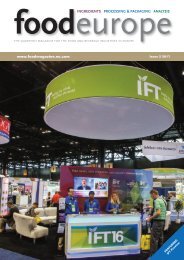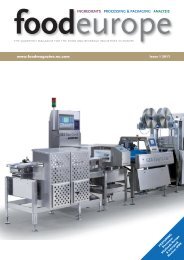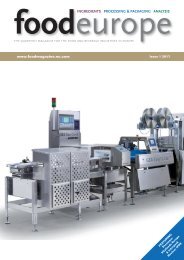Issue 3 2016
You also want an ePaper? Increase the reach of your titles
YUMPU automatically turns print PDFs into web optimized ePapers that Google loves.
packexpo Preview 47<br />
Rovema NA: Two advanced vertical form-fill-seal<br />
bagging machines for food applications<br />
Rovema North America, a designer and provider of packaging machinery for<br />
the food industry, will showcase two advanced Vertical Form-Fill-Seal (VFFS)<br />
Machines. Rovema will exhibit the BVK 260 VFFS Machine with a companymade<br />
servo driven auger and Aroma perm gas flushing system for residual<br />
oxygen levels below 2% to run pillow bags; and the BVC 260, which will be set<br />
up to run Stabilo style to run quad seal bags. Demonstrations of each<br />
machine will take place throughout the show at Rovema’s Booth.<br />
BVK 260 VFFS Bagging Machine<br />
Capable of running up to 120 cycles per minute at format sizes ranging from<br />
60 to 260mm, the BVK 260 VFFS Bagging Machine is ideal for basic bag<br />
shapes, such as flat bags and flat-bottomed bags. It was developed as a replacement for Rovema’s<br />
highly successful VPK-260 continuous motion bagger. Its servo controlled, continuous ‘D’ motion cross<br />
seal station keeps reliable sealing technology at the heart of the bagger’s efficiency.<br />
BVC 260 VFFS Bagging Machine<br />
The BVC 260 VFFS Bagging Machine, a continuous motion, dual-axis servo packaging machine, is capable of<br />
running up to 210 cycles per minute at a maximum forming width of 260mm. Equipped with real-time control<br />
technology that is fully programmable and highly user-friendly, the BVC 260 is highly flexible in terms of the<br />
sizes and styles of bags it can produce, which include pillow, flat-bottom, Stabilo (quad-seal), stand-ups, zipper<br />
recloseable and more. It offers energy efficiency as well as flexibility – especially in its wide range of compatible<br />
packaging material, high process reliability and minimisation of downtimes in the high power range. n<br />
Stand<br />
N-6150<br />
www.algatech.com www.rovema-na.com<br />
Baker Perkins: Focus on ingredients extrusion<br />
Baker Perkins is providing a focus at PACK EXPO on the increasing use<br />
of twin-screw extrusion to produce core ingredients for the food<br />
industry.<br />
It is acknowledged that if it is possible to make a product with an<br />
extruder, it is almost certainly the cheapest, most efficient and most<br />
compact method of making it. Conventional processing typically<br />
involves a great deal more equipment, time and cost.<br />
Stand<br />
E-10123<br />
Here are some typical examples in the ingredient industry. The<br />
traditional process for making breadcrumb involves mixing, forming<br />
and baking bread before discarding the crusts and grinding. The same<br />
product can be made with no waste using only a twin-screw extruder. As well<br />
as the enormous savings in space, equipment, energy and labour this brings the process is also much more<br />
flexible, enabling quick and easy switching between different recipes.<br />
Similarly for croutons, a bread-like texture can be developed in the extruder and the pieces cut to size at the die<br />
or a post-extrusion cutter. Croutons for the ingredients market, such as soups and salads, or a crunchier variant<br />
for the snacks market can both be produced by this method with rapid changes between them.<br />
Extrusion is also an excellent way of addressing the market for gluten-free bread products as it can handle with<br />
ease the various alternative flours and starches used to make the dough. Screw profiles can be adjusted to<br />
achieve the desired characteristics much more readily than conventional processes and it also overcomes the<br />
problems caused by stickiness of the dough.<br />
Extruders also bring a lot of advantages to modified and pre-gelatinised flours used in products such as instant<br />
soups, bakery pre-mixes and infant nutrition. The wide range of conditions that can be created in an extruder<br />
enable characteristics such as rapid and/or cold-water thickening, increased protein or fibre content, improved<br />
dispersibility and enhanced texture to be readily developed. n<br />
www.bakerperkins.com<br />
www.foodmagazine.eu.com issue three | <strong>2016</strong>


